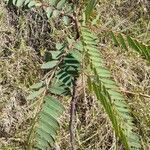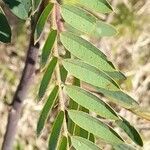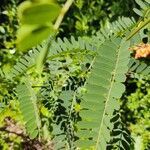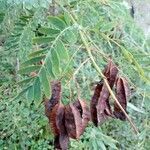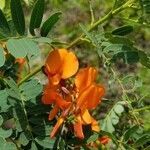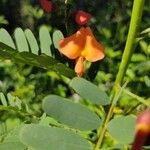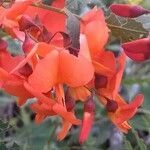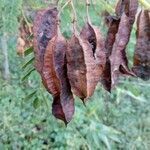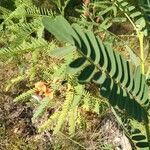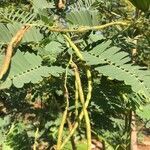Pod pale brown, darker brown in central area over the seed cavities, 4.5–9.2 × 1.3–1.8 cm, linear to slightly falcate, 4-winged, stipitate, beaked, glabrous, (3)4–9(10)-seeded; septa 6.5–8 mm apart, slightly oblique; the main part of the pod (i.e. excluding the wings) torulose with prominent reticulate venation on the valves above the seed cavities.
Leaves 5–16 cm long; petioles 1–1.8 cm long; leaflets in (6)10–18(21) pairs, 1.1–2.9 cm × 3–8 mm, linear-oblong to oblong, rounded at the apex, apiculate, entire, slightly pubescent beneath especially on the margins and also punctate with minute, scattered black dots, the venation very evident beneath; stipules 3–7 mm long, lanceolate, ± persistent.
Deciduous tree or shrub, up to 4 m high. Branches slender. Leaves dark green, drooping, 1-200 mm long. Leaflets oblong, entire, apiculate at apex. Inflorescences of drooping racemes. Flowers red or orange. Flowering time Sept.-Mar. Pod longitudinally 4-winged, oblong, tip sharply pointed. Seeds 4-10 separated by cross-partitions.
Raceme axillary, 4–11.3 cm long, 12–24-flowered; peduncle 1–3.3 cm long, slightly appressed-pubescent especially near the base; pedicels 5–10 mm long, glabrous; bracts 2 mm long, lanceolate, marginally pubescent, caducous; bracteoles 0.5–1 mm long, filiform to narrowly lanceolate, caducous.
Tree or shrub, up to 4 m high. Leaves drooping; pinnate with leaflets in 5-20 pairs, up to 25 mm long. Flowers: in a dense raceme, up to 250 mm long; corolla with standard 16-20 mm long, bright orange to red; Oct.-April. Pods oblong, 4-winged, up to 100 mm long.
Seeds greyish-green to straw-coloured, 6.5 × 5 mm, 4 mm thick (quite distinct in shape from all the African species of the genus) without a rim aril but with a paler coloured raised area around the elliptic (not circular) hilum which is not centrally located.
Calyx a deep red colour in bud, 4.5–6 × 5–7 mm, apically rather oblique, almost truncate, the teeth inconspicuous, 0.5 mm long, broadly triangular, slightly pubescent at the tips.
Young stems glaucous, green to dark-brown, often longitudinally ribbed, glabrous to slightly appressed-pubescent, older stems with cracked greyish-black bark.
Seedlings with first foliage leaf simple, much larger than the persistent cotyledons; second foliage leaf paripinnate with four pairs of leaflets.
Deciduous shrub to 4 m. Leaves pinnate, leaflets oblong. Flowers in axillary racemes, red and orange. Pods 4-winged, pungent.
Ovary arcuate, glabrous, not winged; style glabrous.
Shrub or small tree, 1–4(5) m tall.
Petals red or bright orange.
